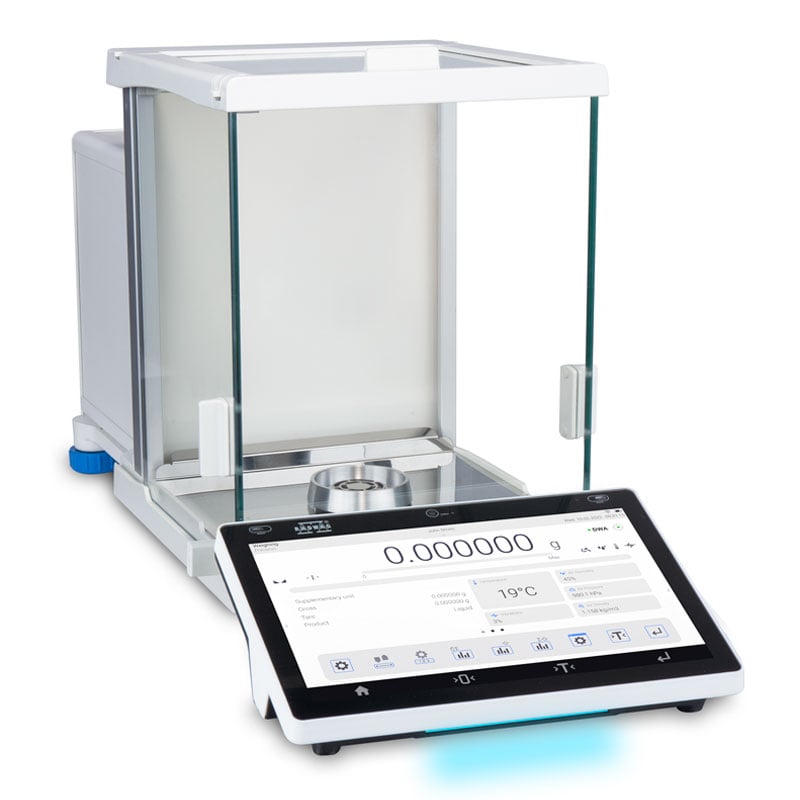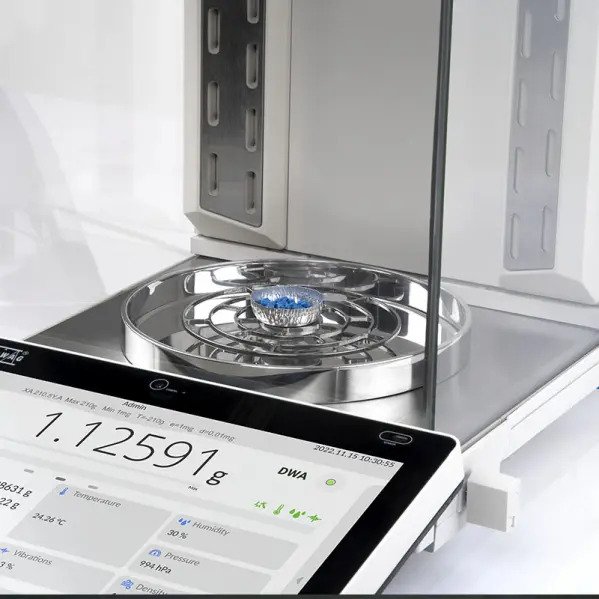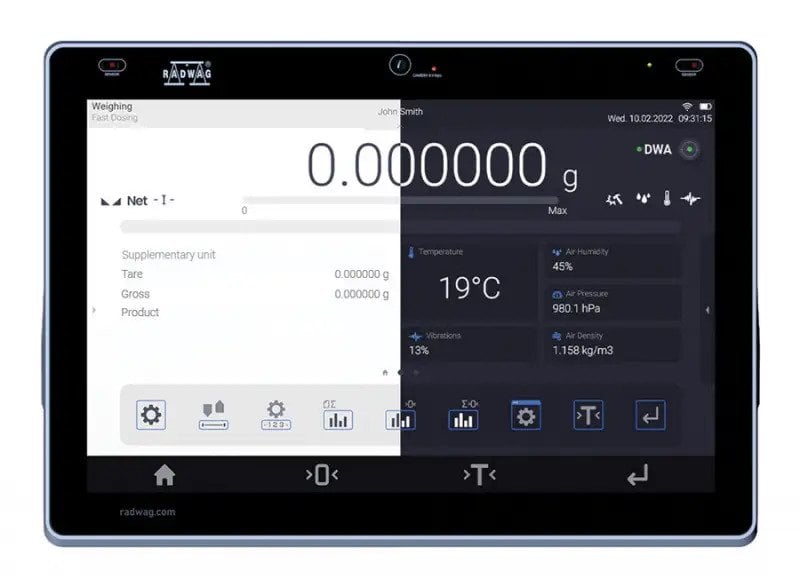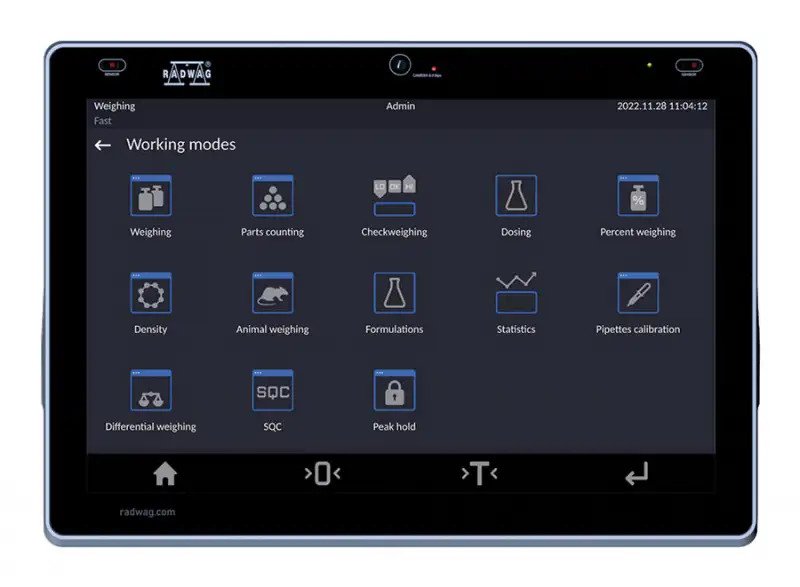XA Microbalance with 10" Touch Screen XA
Overview
Digital Weighing Auditor
- Ensures Balance Readiness: Enables real-time air buoyancy compensation to ensure your balance is always ready for use.
- Balance Inspection Alerts: Notifies you when a balance inspection or periodic audit of accuracy and sensitivity is needed.
10-Inch Display
- Larger Screen for More Information: The 10'' ELLIPSIS terminal displays up to three screens, widgets, graphs, statuses, notes, and measurement history in one place.
Uncompromising User Verification
- Multi-Method User Verification: Verifies the user using a password, RFID card, fingerprint reader, facial recognition, or any combination of these methods for enhanced security.
Ambient Light
- Innovative Communication: The balance uses light colours to indicate status, process results, procedures, or alerts.
Hotspot
- Remote Access: Operate the balance from any device connected to it, such as a smartphone, tablet, or computer.
RFID
- Product and User Identification: Works with RFID tags for tagging products or formulation ingredients in the database and for user identification.
Live Note
- Voice and Text Notes: Add voice memos or text notes to measurement series or procedure reports for the first time.
Handy Library
- Recent Measurements and Reports: Stores recent measurements or reports ready for digital signature, compliant with 21 CFR Part 11.
Widgets
- Custom Display: Widgets are prepared to display the most relevant information for your needs at any given moment.
Automatic Levelling with ReflexLEVEL System
- Automatic Scale Levelling: The ReflexLEVEL System automates the levelling process, saving time and ensuring maximum precision.
Smart Min Weight
- Minimum Weight Indicator: Displays whether the weight you want to measure is below or above the minimum weight threshold.
Two-Point Adjustment
- Enhanced Measurement Precision: Adjustment at two measurement points instead of one improves precision across the entire weighing range, resulting in more accurate measurements.
Technical Data
-
BrandRadwag
-
Capacity6.1 g
-
Electrical12V DC
-
Readability1 ľg
Support & FAQs
At Thermoline, we strive to supply helpful customer support to ensure that you get the most out of our products. We are committed to providing whatever support our customers need, wherever they are in the world. If you can't find your solution in the below FAQs or Knowledge Base, please contact our friendly support team.
- What is laboratory balance?
A laboratory balance is a precision instrument used to measure the mass of an object or sample. It is designed for use in laboratory settings and is typically more accurate and precise than a standard scale.
A laboratory balance typically consists of a weighing platform, a load cell to measure the weight of the sample, and a digital display that shows the result. The load cell converts the force of gravity acting on the sample into an electrical signal, which is then displayed on the digital display.
- What is the difference between a scale and a balance?
While scales and balances are both used as weighing devices, their intended purposes vary slightly.
A scale is used to measure weight (weight = the force of gravity on an object on the scale), whereas a balance is used to measure mass. (mass = the amount of matter in an object). A scale is a general-purpose measuring instrument that gives an estimate of the weight of an object. They typically use spring mechanisms to measure weight and have a lower precision compared to laboratory balances.
A balance, on the other hand, is a highly precise instrument used in laboratory settings. Balances use load cells to measure weight and provide a much higher level of accuracy compared to scales. The readout on a balance is usually digital, and the results can be displayed in various units of measurement, including grams, kilograms, and ounces.
- What are the appropriate conditions for a laboratory balance?
- You should first install the balance in a workroom free of vibrations and shakes and where there is no air draft or dust. You want to ensure that the ambient temperature is between +15°C and +35°C while ensuring that the relative humidity is not above 80%. Place the balance either on a robust-design table or on a wall bracket that is both distant from heat sources and insusceptible to vibrations.
- What is the difference between a precision balance and an analytical balance?
Precision balances and analytical balances are both types of laboratory balances, but they differ in their level of precision and the types of applications for which they are used.
A precision balance is a type of laboratory balance that provides accurate measurements within a range of ±0.1 to ±0.01 grams. Precision balances are typically used for routine weighing tasks, such as determining the mass of chemicals for routine laboratory experiments, or for checking the weight of small parts in industrial settings.
An analytical balance, on the other hand, is a highly precise type of laboratory balance that provides accurate measurements within a range of ±0.0001 grams. Analytical balances are used for more demanding applications, such as determining the mass of samples for highly accurate chemical analysis, or for weighing minute quantities of substances in medical and pharmaceutical research.





